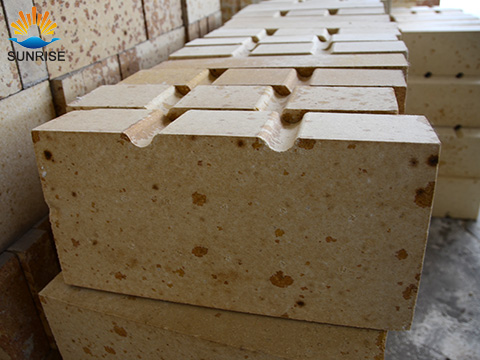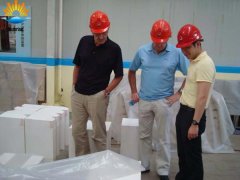Products List
- Silica brick for glass kiln...
- BG-98 superior silica bricks for gla...
- Insulating silica brick...
- High thermal shock resistance and ze...
- High bulk density and High thermal c...
- Unshaped refractory Silica Refractor...
- Silica brick for hot blast stove...
- Silica brick for coke oven...
- Silicon brick for carbon furnace...
Classic Case
-
British Refractories customers to
June 7, 2011 the British Refractories Company custo...
-
Turkish customers to visit our fa
On 26 July,2013 Turkey customers visited our fact...
Refractory Knowledge
Causes of the Spalling and Stoning of Silica Bricks
Date:2016-02-19 17:24 From:Zhengzhou Sunrise Refractory Author:admin
Silica brick has bad resistance to alkali oxides. It is usually used in the upper part of breast wall and the crown.

The corrosive agent in the furnace is mainly R2O. After eroded by a large amount of R2O, the melting point of the surface layer of the silica brick will sharply decrease and there will be bell emulsion droplets. However, in normal situations, there is no bell emulsion corrosion. Only when the flame causes local overheating, the brick will be corroded. The silica brick in the crown has smooth surface and obvious metamorphic layer after eroded. In the metamorphic layer, there is only SiO2 crystal.
The proliferation and invasion of Na2O has good mineralization effect on the growth of tridymite. So, in the corroded zone of silica brick, the recrystallization of tridymite plays an important role. In the highest temperature zone, the inner surface of silica brick is cristobalite. The theoretical transformation temperature of tridymite to cristobalite is 1470℃. If tridymite coexists with R2O, the transformation temperature can be reduced to 1260℃.
Whether it is recrystallization or polymorphic transformation, the combination between the particles of silica bricks can be weaken. The brick may be broken or even spall due to expansion. The main source of silica brick stones is the corrosion and spalling of silica bricks during the use.
When there are cracks or large gaps in the silica brick, R2O gases will enter the bricks though those cracks or gaps and be condensed into liquid at 1400℃ due to the low temperature in the brick cracks. The liquid can corrode the brick and generate holes (commonly known as rat holes). The air cooling can accelerate the condensation of R2O and corrosion of bricks. so, for the construction of silica brick, it is important to reduce the brick joints and control the temperature under 1600℃. Insulating the crown can prevent the condensation of R2O and reduce corrosion. This can not only save energy but also protect the crown roof and expand the service life.
The stones generated by the silica brick crown are rare since the main composition of silica brick is SiO2. SiO2 is easy to diffuse and will be homogenized or generate transparent stones in the glass liquid. The transparent stones with a high SiO2 content contain tridymite and cristobalite crystals. Since there is Fe2O3 in the silica brick, it is yellowish green seen with naked eyes. During the melting process, the silica brick in the crown may be melt and flow downward, which may cause the corrosion of fused cast AZS block in the lower part and generate stones when entering the glass liquid.
Contact Us
- E-mail :sales@sunriserefr.com
- Phone : +86-371-63838939
- Fax:+86-371-63835539
- Company Address : No.36 Fengchan Road Of Zhengzhou, Henan, China (Mainland)



